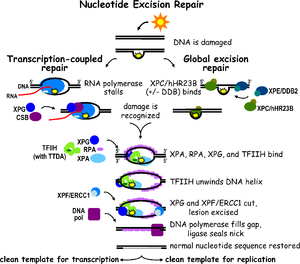User:Ritagbpalma/Sandbox
Mutagenesis and Types of DNA Repair[edit | edit source]
Mutagenesis
Definition
- Process by which the genetic information of an organism is changed in a stable manner, leading to a Mutation [1].
- Spontaneously/result of exposure to mutagens/ experimentally
- Can lead to cancer and various heritable diseases, but it is also the driving force of evolution
Classification:
- by cause: spontaneous / induced
- by effect on structure: small-scale / large-scale
- by impact on protein sequence: frameshift, missense, nonsense, neutral, silent
DNA Repair
Definition
- Major defence against environmental damage to cells
- Present in all organisms
- Involved in processes that minimize cell killing, mutations, replication errors, persistence of DNA damage
Types
- Direct Reversal
- Base Excision Repair
- Nucleotide Excision Repair
- Mismatch Repair
1. Direct reversal
- Does not require a template
- Specific to the type of damage incurred
- Does not involve breakage of phosphodiester backbone
Types:
- Thymidine dimers
- Methylation of guanine bases
- Methylation of cytosine and adenine bases
2. Base Excision Repair (BER)
Removal of the incorrect base by DNA N-glycosylase (create AP site), then AP endonuclease removes the AP site and neighboring nucleotides. The strand is extended by a DNA polymerase I and DNA ligase.
3. Nucleotide Excision Repair (NER)
Proteins are responsible for removing damaged nucleotides. The gap is then filled by DNA polymerase I and DNA ligase.
Error in NER leads to Precanceroses (Xeroderma pigmenosum).
NER differs from BER in:
- Different enzymes
- Nucleotide is removed along with many other adjacent nucleotides (NER removes a large "patch" around the damage)
- NER can only recognize lesions that distort the DNA helix
- BER is limited by the fact that the number of glycosylases that can recognize damage and initiate repair is limited
4. Mismatch Repair
Deals with correcting mismatches of the normal bases (Watson-Crick base pairing). The faulty strand is neicked at the nearest GATC base sequence. Enzymes in this process are involved in both base-excision repair and nucleotide-excision repair.
Error leads to Hereditary non polyposis colon cancer.

